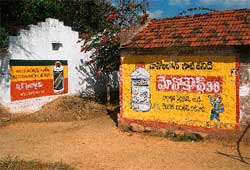False, misguided steps
 the reasons for the unprecedented pest attack and pesticide resistance in ap are not hard to find. Pests have a deep association with the host plants. Crop rotation interrupts this relationship. This is not followed in ap any more, the same crops being grown season after season, year after year. This results in build up of pests specific to the crop, who then develop resistance to pesticides.
the reasons for the unprecedented pest attack and pesticide resistance in ap are not hard to find. Pests have a deep association with the host plants. Crop rotation interrupts this relationship. This is not followed in ap any more, the same crops being grown season after season, year after year. This results in build up of pests specific to the crop, who then develop resistance to pesticides.
Cultivation of intercrops, such as soybean, greengram, jowar and castor, help in keeping pest populations under control by providing shelter to the natural predators of the pests. While indiscriminate use of pesticides leads to resistance in pests, it harms the natural predators. There are a number of natural predators of the bollworm, such as mantis and spiders, and parasites like Campolitis chloridae.Birds like the mynah feast on harmful insects and help maintain their population at manageable levels. Alarmed at the S litura , farmers used bait poisoned with methomyl, which killed also the predatory birds. In the cotton growing areas of ap , entire ecosystems have been destroyed. "In Warangal, no natural parasite or predator can be seen today," says Tewari.
In Guntur, Adilabad, Prakasam, Kurnool, Warangal, Khammam and Krishna districts of the state, crop rotation has been forgotten in favour of cost-intensive cash crops such as cotton. Targets are fixed by the government and private agencies and the farmers brainwashed into thinking that there is absolutely nothing as beneficial as cotton, especially through the new high-yield hybrid varieties. Hybrids require more inputs in terms of fertili-sers and pesticides as they are more susceptible to pest attacks. Crop rotation including pulses, oilseeds, cereals or vegetables are not as remunerative as cotton, with the result that farmers sow cotton year after year.
This is exactly what pests such as the bollworm need. If their host remains the same over large areas year after year, they build up in large numbers. Rather than applying a fertiliser with balanced nutrients, the farmers - new to modern agricultural practices - choose to dump nitrogen fertilisers, which have a deleterious effect on helpful soil microbes. This has been observed in district Guntur, where complete absence of beneficent microbes has been reported.
However, beyond these problems, pest attacks on cotton also has grave economic and trade implications for India. Cotton is a very important factor in the country's commercial sector. Market blues
India's textile industry, built around cotton, has a weighted average of 20 per cent of the entire industrial output of the country. Textiles earn 33 per cent of the country's foreign exchange. India's cotton exports are worth Rs 6,000 crore, and include raw cotton, cotton yarn and textiles.
The price of cotton has fallen from Rs 2,500/100 kg in 1995-96 to Rs 2,300 in 1996-97. This season, the price is Rs 1,800/100 kg. The Cotton Corporation of India has been persuaded to buy at the rate of Rs 2095/100 kg. I ndia's cotton production is expected to be 16,000,000 bales in 1997-98, as against 17,650,000 bales in the last fiscal year, according to M P Gajaria, secretary general, Indian Cotton Mills' Federation (icmf). He says that current slump in production and supply of bad quality cotton would hit the textile industry. India is facing shortage of cotton at a time when cotton requirement is expected to increase by four per cent. "Untimely and extensive use of spurious pesticides are resulting in low production and bad quality of cotton," he says.
Indiscriminate use of pesticides also leads to the outbreak of the white fly. During the mid-1980s, thousands of bales of cotton in district Guntur could not be spun due to excessive stickiness. This happens when honey dew producing insects, such as the white fly and aphids, attack cotton plants. The honey dew drips off the leaf surfaces and collects on the lint in the open bolls. Effective control measures for white fly and aphid populations in the field would significantly eliminate this contamination.
A study by the International Textile Mills' Federation shows that Indian cotton is one of the most contaminated in the world. This explains why it gets relatively lower prices in both domestic and international markets. The study reveals that none of the Indian cotton varieties find a place in the list of least contaminated varieties, which contained 31 descriptions from other countries. Due to the use of conta-minated cotton, Indian export oriented units are facing tough times in the international market.
The immediate future looks bleak. Pests resistant to chemical pesticides are here to stay. Insects in ap have shown that they are one step ahead of the chemicals that could have been used against them. Successful implementation of a practicable and integrated strategy for cotton cultivation with minimal use of pesticides and based on ipm has become imperative.
With inputs from Indira Khurana and Manish Tewari, New Delhi.
